Intercultural Communication professor grateful to help shape China’s burgeoning IC discipline
As a young boy growing up in the U.S., Steve J. Kulich first became aware of China after seeing Chinese characters on the wrapping paper of fireworks. In college it was his Chinese classmates who fostered his interest in seeking a teaching job on this side of the world. After working for a number of years among Chinese, he met his German wife, and their shared interests led the newlyweds to study Chinese at tranquil Xiamen University. Later, the young family moved to Shanghai with their two daughters, where they have now lived for 25 years. Multicultural at home and embracing cultures in his work life, he has actively engaged in intercultural communication to bridge the increasingly dwindling gap between China and the world.
As a scholar, Steve is now Executive Director of Shanghai International Studies University’s (SISU) Intercultural Institute (SII) and engages in research on intercultural values and identity. In a modest library room at SISU, we met Steve – the same room where the first segments of the SISU-FutureLearn “Intercultural Communication” MOOC course were filmed, taught twice a year and to date enrolling 45,000 online learners around the world. Through him and the SISU Educator team, Chinese students meet the world and the world gets to know more about intercultural aspects of Chinese cultural identities, values, and communication styles.
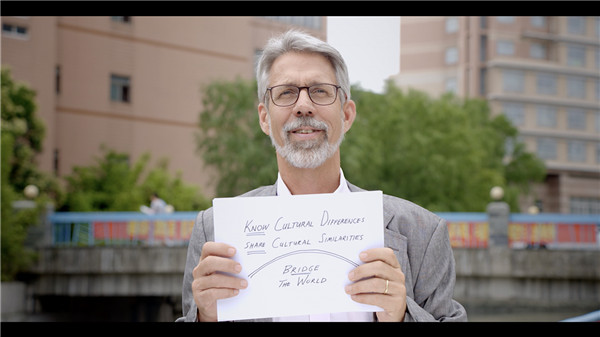
(Steve J. Kulich, Executive Director of the SISU Intercultural Institute)
Personal and academic home
In the summer of 1981, after teaching for two years in Taiwan’s Tunghai University, Steve first set foot on the Chinese mainland. His two-week-long journey ended with a three-day stay in Shanghai. The many factories, busy workers, clanging of bicycle bells, and busses full of people were his first impressions, but also signs of the new opening-up policy, with some colorful clothes appearing among the traditional blue and grey Mao suits, the first big billboard advertisements (surprisingly of “The Marlboro Man”), and a few shiny imported motorcycles and cars.
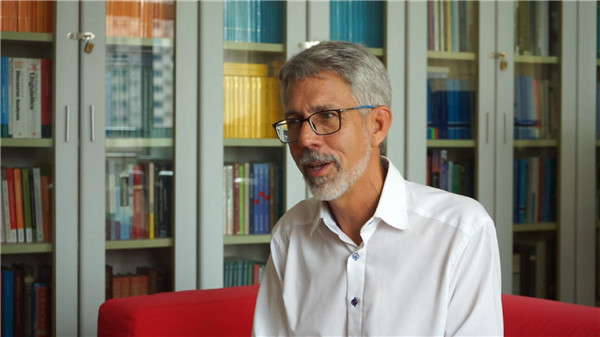
(Steve has an interview with Eastday.com)
Though China’s reform and opening up had started, in Steve’s eyes, Shanghai did not change very much in the 1980s. Developments took off after Deng Xiaoping’s Southern Tour, just before the Kulich family moved to SISU. High-rise buildings and overpasses quickly began springing up. Coal burning factories were moved out, construction of new housing or office areas became omnipresent and he saw a new Manhattan taking shape.“Everything was just picking up, and we had this sense that we could be part of this developing city and somehow contribute,” said Steve.
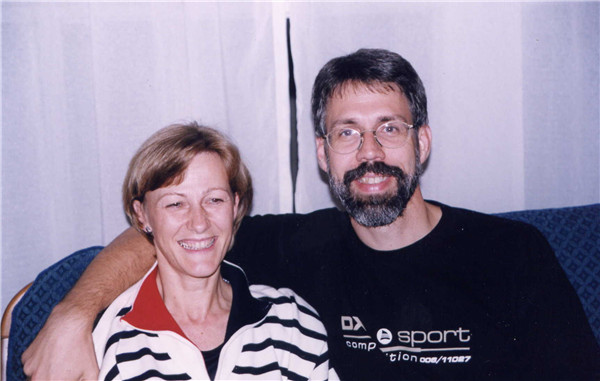
(Steve and his wife in the 1980s. Photo provided by Steve J. Kulich)
The international atmosphere here was another reason why he and his family chose Shanghai. Coming in 1993 with two young children, an environment with good hospitals, educational options, and some German-speaking families for language and cultural support were attractive. Many German companies had joint ventures in Shanghai, like Volkswagen, Siemens, Henkel, and with an active German consulate, there was hope of possible German school support as the children grew, which indeed happened. After attending Chinese kindergarten and 3 years of Chinese primary school, both girls graduated from the German School Shanghai and his wife served on the school board and as a consulting doctor for the consulate.
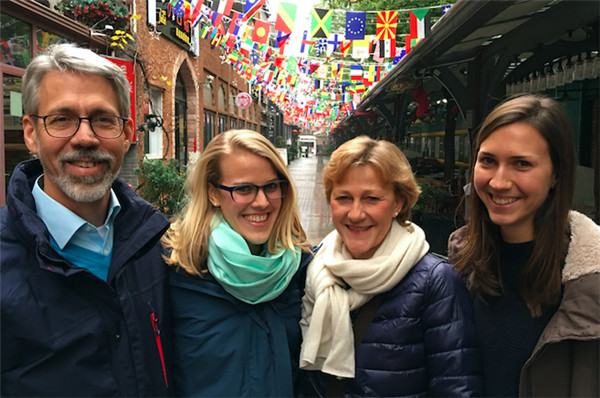
(Steve and his family. Photo provided by Steve J. Kulich)
With a master’s degree in intercultural communication, Steve started to teach at SISU’s Overseas Training Center in 1993, primarily providing training for scholars preparing to study abroad and employees upgrading their competencies for State-owned Enterprises and multinational enterprises. It was there that he started intercultural communication orientation courses in 1994 and also sought contact with Chinese scholars pioneering the intercultural communication field here.
When he had previously undertaken a survey of China’s understanding of intercultural communication for his master’s thesis, he could find only five books, none of which were particularly deep. However, the academic field, which grew out of comparative studies in anthropology, psychology, education and communication, had formalized in the US by 1970. By the time Steve finished his MA in 1992 IC was mature and also expanding in Japan, Germany, France and other countries. However, when it came to East-West cultural comparisons, many people reverted to Japanese and American comparisons. For various reasons, the world’s understanding of China, and China’s of the world, were lagging behind. But by the late 1980s, Chinese teachers were focusing more on language and culture teaching, and similar to Steve at SISU, intercultural communication courses were opened in Beijing Foreign Studies University (BFSU), Harbin Institute of Technology (HIT), Beijing University, Fujian Normal University, and other Chinese universities. It was a great time to come, contribute, and collaborate!

(Steve’s library room is full of intercultural research literature and textbooks.)
In 1995 Steve was thrilled to learn of the founding of the China Association for Intercultural Communication (CAFIC) in Harbin, and in 1997 he attended its second conference at BFSU. Since then, that association has been his domestic academic home. Its members are mostly teachers and scholars from various fields like FLT (Foreign Language Teaching), TCFL (Teaching Chinese as a Foreign Language), linguistics, translation studies, communication, and psychology, who gather to share their latest work on intercultural research and education. Seeing a need for stronger academic publications to develop the field, Steve initiated a thematic book series called Intercultural Research (published by SISU’s press, SFLEP) though he and his co-editors have recruited top scholars from China and abroad to publish on topics like identity, values, adaptation, and interculturality (the series has been recognized for several best book awards).
Thanks to the relationships built through the association’s annual conferences, in 2003 Shanghai became the first, and still sole, city recognized with an official branch. Compared with other Chinese cities, Steve thinks Shanghai has past and present advantages in terms of intercultural communication research. “There are quite a few universities in Shanghai interested and engaged in this area because of the need to communicate with the world, and Shanghai has a history of being an international city.” In addition to annual faculty meetings and an important conference series, the Shanghai CAFIC branch also organizes inter-school graduate thesis competitions to promote mutual interaction and collaboration between universities. “I’ve been very lucky to grow up with the discipline here,” said Steve.
Developing a discipline to develop people
Steve’s Chinese name is 顾力行 (Gu Lixing), which, according to him, summarizes his life purpose. “力 (Li) means that I try to depend on God’s strength to provide what I need every day to cultivate inner capacity. 行 (Xing) is to live out that capacity. 顾 (Gu) is to seek to be a good advisor or help to care for others.” His name is therefore a reflection of his dedication to China’s education.
At SISU, Steve not only founded intercultural communication (IC) courses, but several IC programs. In 2002, he was asked to start the intercultural communication MA program, and by recruiting a group of like-minded local and overseas colleagues, they have trained over 300 MA graduates in IC. During 2005, he, Prof. Zhang Hongling and several others at SISU drafted plans for a research center to integrate resources, promote the development of the discipline, and better serve the university and its students.
Thanks to university-level support, the SISU Intercultural Institute (SII) was launched in September 2006 and has steadily grown in staff members and influence. Currently, there are eight core academic scholars/staff on the team and other affiliated partners in other colleges. SISU has become one of the leading locations for teaching and researching IC as an interdisciplinary subject, especially through the IC “state of the field” and “disciplinary development” conferences that were hosted in 2006, 2010, 2014, and 2016, and publication of the institute’s books and key articles. Since 2010, SISU has been recruiting PhD students and more than a dozen of the first graduates are now working to build the field in universities across China.

(Inauguration ceremony for the SISU Intercultural Institute. Photo provided by Steve J. Kulich)
As Executive Director of SII, Steve has many responsibilities. Admittedly relying heavily on his team for administration, research collaboration, and the wide range of roles the SII is asked to perform, he feels that his greatest strengths are in understanding the history of the field, getting to know key scholars, building international cooperation, and sharing this with his students in the classroom.“I’m good at encouraging other people and motivating other people to do their research. In fact, the motto of our Institute is ‘developing a discipline to develop people.’ I really feel that intercultural teaching, training and doing research makes you more aware of how to compare, contrast and adapt, so people can grow as better people. We call it intercultural competence, international awareness, global citizenship and many different terms, so I feel pleased I’ve been able to invest in that.”
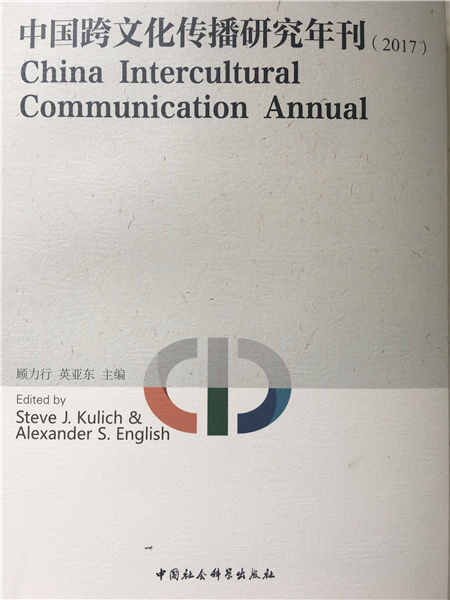
(Steve is the co-editor of China Intercultural Communication Annual (2017). Photo provided by Steve J. Kulich)

(Steve and SII’s fellow team in the early years of SII. Photo provided by Steve J. Kulich)
Steve’s teaching career at SISU also gives him plenty of research inspiration, which he is always grateful for. When he was teaching in SISU’s Overseas Training Centre from 1993-2002, he was exposed to different kinds of Chinese, allowing him to make systematic and localized research on Chinese values. “We’ve filled out a lot of small questionnaires and surveys. I’ve gathered a lot of data, and just talking with my students every day in class was a learning experience. Every day I learn something new.”
Being imbedded in the system and in relationships all these years, when he started presenting papers at international conferences, people were intrigued by new perspectives on China. Much international scholarship still focuses on linking Chinese ideas or behavior to Confucianism as a basis for face practices, guanxi, or collective stereotypes. But by linking his student’s feedback with international values survey and the cultural psychology of bi-lingual identities, Steve could use research to tell updated Chinese stories on people’s motivations, daily lives, social relationships, modernization and culture change trends in China today. As Steve said, “For my research on values change, identity development and social interaction, this job has been perfect for me.”
Last year, Steve was elected as incoming president of the IAIR (International Academy for Intercultural Research), an executive role for six years. In addition, SISU was approved as the host for the next biennial conference of the IAIR in 2019 (to be held jointly with CAFIC), coinciding with SISU’s 70th anniversary! While he grows into his presidential role, he and his team are busily preparing for this significant opportunity to showcase SISU, domestic IC scholars, and today’s China. “Our goal is to recruit many more top Chinese scholars into the Academy, either as academic fellows or members to learn from people from countries such as Germany, France, South Africa, Ghana, and Norway. We have so many countries that are doing intercultural research now, so we can connect to the world. That’s the idea of China’s vision of globalization, and of how we can really build this shared future for mankind.”
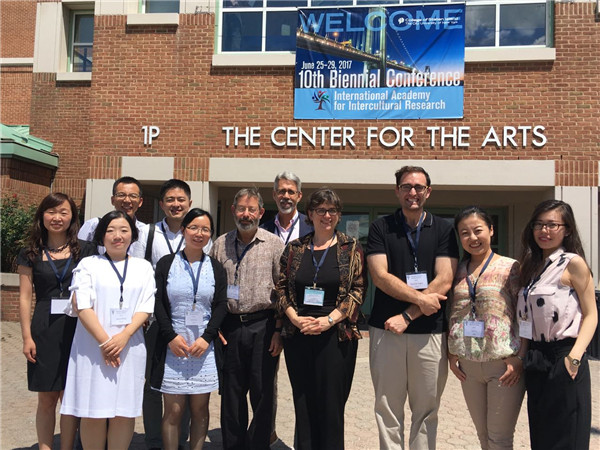
(Steve attended the 10th IAIR Biennial Conference in New York in 2017. Photo provided by Steve J. Kulich)
“Intercultural communications can truly contribute to that dialogue,” added Steve,“telling Chinese stories, but also helping the world understand China through first-hand experience.”
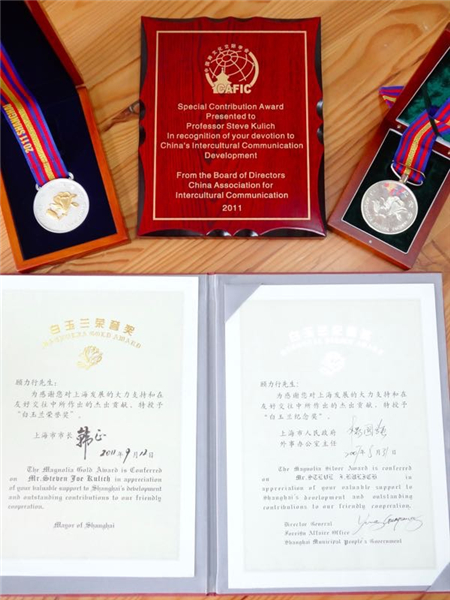
(Steve won Shanghai Magnolia Silver and Gold Awards in 2007 and 2011. He was also honored with a Special Contribution Award from CAFIC in 2011. Photo provided by Steve J. Kulich)
As a self-titled “human developer,” Steve pays more attention to people’s personal cultivation and encourages the personal and national benefits of people-to-people exchanges. China already has a leading position in many areas in the world, such as exports, imports, and the largest PPP (a competing measure to GDP that takes into account the relative cost of local goods, services and inflation rates) economy. Therefore,“We should use this ability to really build through the Belt and Road initiative, and be giving, be exchanging, and working together. I think that’s the spirit that needs to keep happening.”

(Steve’s wishes for China’s further reform and opening up)
